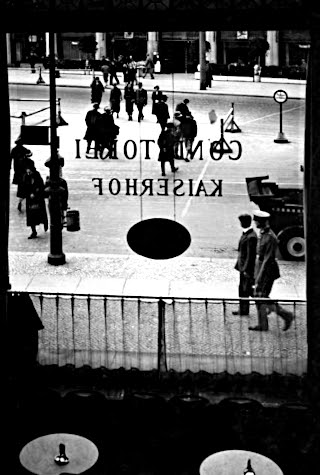09 January 2009
Citi Unloading Robert Rubin and Salomon Smith Barney
 We hope that Teflon Bob will not be finding a position with the Obama Administration. If he does they might have to drop the 'reform' label on that Administration. This is starting to look more like the shift change at the Rogues Gallery.
We hope that Teflon Bob will not be finding a position with the Obama Administration. If he does they might have to drop the 'reform' label on that Administration. This is starting to look more like the shift change at the Rogues Gallery.
Citi is also said to be shopping (trying to unload) its Salomon Smith Barney brokerage division. They are said to be in talks with Morgan Stanley. Apparently MS is finding its current life as a bank holding company a bit timesome, coming in at 10 and out on the links by 3.
How fast time flies on the Street. It seems like only yesterday that little Philbro was in short pants, and then its first pair of white shoes. Then they grow up and rig the Treasury market and help set up the dotcom bubble, those little scamps.
Both Citi and JP Morgan continue to be plagued by rumours of large undisclosed losses and troubled positions.
Since Bob Rubin was on Sandy's and Vikram's A team, one has to wonder. As Pliny the Elder observed, "Ruinis inminentibus musculi praemigrant:" When collapse is imminent, the little rodents flee.
Wall Street Journal
Rubin to Leave Citigroup
By DAVID ENRICH
Robert Rubin, the former Treasury secretary who has been sharply criticized over his role in the financial turmoil at Citigroup Inc., is leaving the bank.
Mr. Rubin is senior counselor and a director at the New York company, which has suffered $20 billion in losses over the past year and got a government bailout of at least $45 billion. Citigroup's troubles cast an awkward spotlight on Mr. Rubin, who received $115 million in pay since 1999, excluding stock options.
Citi said in a statement that Mr. Rubin retired decided to retire as senior counselor effective Friday and decided not to stand for re-election as a director at the company's next annual meeting.
"Since joining Citi nearly 10 years ago, Bob has made invaluable contributions to the company," said Vikram Pandit, Chief Executive Officer of Citi.
While Mr. Rubin has defended his performance since joining Citigroup in 1999, insisting that the bank's problems were due to wider turmoil in the financial system, not failures by Citigroup, he is "tired of it," a person familiar with the matter said. Mr. Rubin now wants to focus instead on his non-profit work and other outside interests.
The exit of Mr. Rubin likely will do little to ease the questions swirling around Citigroup, now just the fifth-largest U.S.-based bank as measured in stock-market value. Since late 2006, Citigroup's share price has plunged nearly 90%. On Friday, the stock was down more than 5% in recent New York Stock Exchange composite trading.
Besides an initial $25 billion injection as part of a broad rescue of financial firms, the government agreed in November to put in $20 billion more and vowed to protect Citigroup against most losses on $306 billion of its assets.
The second infusion, which the government as the bank's largest shareholder, with a 7.8% stake, coincided with federal regulators putting Citigroup on a tighter regulatory leash, according to people familiar with the situation said.
Federal banking regulators have toughened their scrutiny of Citigroup, becoming involved in internal discussions about the company's strategic direction and discouraging executives from pursuing certain acquisitions.
In an interview with The Wall Street Journal in late November, Mr. Rubin said risk-management executives are responsible for navigating around problems like those now battering Citigroup. "The board can't run the risk book of a company," he said in the interview. "The board as a whole is not going to have a granular knowledge" of operations.
Still, Mr. Rubin was deeply involved in a decision in late 2004 and early 2005 to take on more risk to boost flagging profit growth, according to people familiar with the discussions.
Mr. Rubin also played a major role in getting Mr. Pandit appointed as Citigroup's chief executive in December 2007, following the resignation of Charles O. Prince.
In the Journal interview, Mr. Rubin said Mr. Pandit was doing a good job and would prosper in its current structure once the financial crisis eases.
Merrill Lynch: The Wealthy Are Turning to Physical Gold for Safety
 And so it begins...
And so it begins...
Each person has to allow for their own circumstances, and provide for their daily needs as well as their longer term investment decisions.
Speculation and leverage are a trap in this market, because it is permeated by abusive practices and a deterioration of the conditions necessary to free markets.
It is truly amazing that the world continues to allow New York, Chicago and London to set the short term prices for their goods and labor.
The status quo will do all in its power to perpetuate itself, and hold the line on meaningful change and reforms for a variety of all too human motivations. This, we believe, is what has been causing this series of bubbles, booms and busts. Bernanke is fighting the last economic crisis.
As we can, provisions should be made for the troubles to come. We did not get where we are overnight, and we will not repair ourselves in a year either.
UK Telegraph
Merrill Lynch says rich turning to gold bars for safety
By Ambrose Evans-Pritchard
Last Updated: 10:32AM GMT 09 Jan 2009
Merrill Lynch has revealed that some of its richest clients are so alarmed by the state of the financial system and signs of political instability around the world that they are now insisting on the purchase of gold bars, shunning derivatives or "paper" proxies.
Gary Dugan, the chief investment officer for the US bank, said there has been a remarkable change in sentiment. "People are genuinely worried about what the world is going to look like in 2009. It is amazing how many clients want physical gold, not ETFs," he said, referring to exchange trade funds listed in London, New York, and other bourses.
"They are so worried they want a portable asset in their house. I never thought I would be getting calls from clients saying they want a box of krugerrands," he said.
Merrill predicted that gold would soon blast through its all time-high of $1,030 an ounce, and would hit $1,150 by June.
The metal should do well whatever happens. If deflation sets in and rocks the economic system it will serve as a safe-haven, but if massive monetary stimulus gains traction and sets off inflation once again it will also come into its own as a store of value. "It's win-win either way," said Mr Dugan. He added that deflation may prove the greater risk in coming months. "It's very difficult to get the deflation psychology out of the human brain once prices start falling. People stop buying things because they think it will be cheaper if they wait."
He added that deflation may prove the greater risk in coming months. "It's very difficult to get the deflation psychology out of the human brain once prices start falling. People stop buying things because they think it will be cheaper if they wait."
Merrill expects global inflation to hover near zero, with rates of minus 1pc in the industrial economies. This means that yields on AAA sovereign bonds now at 3pc will offer a real return of 4pc a year, which is stellar in this grim climate. "Don't start selling your government bonds," Mr Dugan said, dismissing talk of a bond bubble as misguided. (Government bonds are a safe haven for now on the short tend of the curve, but to say there is no bubble on the long end is remarkable. The only vairable is how long before that bubble bursts. The real question is whether the risk is worth the return for you, and that will vary. It seems insane to hold the long end when you can take the shorter end. - Jesse)
He warned that the eurozone was likely to come under strain this year as slump deepens. "There is going to be friction as governments in the south start talking politically about coming out of the euro.
I don't see the tensions in Greece as a one-off. It is a sign of social strain in countries that have lost competitiveness." (Wait until it really gets rolling in the US, UK, Russia and China. Then there will be headlines - Jesse)
Daily Telegraph
Gold rush erupts over financial crisis
By Nick Gardner
January 10, 2009 12:01am
THE global financial crisis has sparked a new gold rush.
Worried investors seeking a safe home for their money are ploughing billions of dollars into the precious metal in a bid to preserve their wealth.
Demand has now reached such unprecedented levels that the Perth Mint, Australia's biggest wholesaler of gold coins and bars, has been forced to ration its sales.
Perth Mint's bullion sales rose 194 per cent in the December quarter compared with the corresponding period in 2007, while silver bullion sales were up 140 per cent.
The mint has suspended sales of all gold bars and all bullion coins - except its 1oz "Kangaroo" gold bullion coin. On Monday, after a three-month suspension, it will expand its range of bullion coins for sale but the restrictions remain in place for minted gold bullion bars so the mint can sell some gold to as many customers as possible.
On Monday, after a three-month suspension, it will expand its range of bullion coins for sale but the restrictions remain in place for minted gold bullion bars so the mint can sell some gold to as many customers as possible.
"We are working three shifts a day, six days a week, and still can't keep up with demand," Perth Mint CEO Ed Harbuz said. "I've never known anything like this in the precious metals market.
"We would be working Sundays too but we are having difficulty getting enough staff."
Non-minted gold in the form of cast bars produced by Perth Mint's local refinery can still be bought, although customers who want the bigger bars often have to wait several weeks.
One customer recently bought $500,000 worth of bullion and wanted it delivered so he could hold it personally.
"For very big orders we normally keep the gold in our depository for security reasons," Mr Harbuz said.
"Orders of $10 million or more are not unusual. Often the orders are much larger if we are dealing with pension funds or institutional investors."
The December Non-Farm Payrolls Report: Portrait of a Ponzi Economy
The 'headline number' is the seasonally adjusted net change in jobs. The drop out of the range that was held in the prior years is obvious on this chart.
This is the (in)famous Birth Death Model from the Bureau of Labor Statistics in which they add jobs as a 'plug' to account for new jobs being generated by the economy from smaller business. The trend is very regular as can be seen on this chart. So regular in fact that it is exposed as imaginary, useless. They do not even bother to trend it with the overall economy and jobs market. The only good thing that can be said about it is that it is added to the non-adjusted jobs number first, so its effects are swallowed up by the seasonal adjustment in many months.
This chart shows the drop off in jobs growth was precipitous. We believe that it was much less precipitous ex government fudging. The recessionary decline was masked by the government. Well, its obvious now.
It always good to remind ourselves of the huge swings in jobs numbers before the seasonal adjustments. It is those adjustments, and the huge revisions made to the series both in the prior month and in whole sections of the numbers, that hide a multitude of statistical sins.
This chart shows the peak in the economy, and the beginning of the decline. As one can see it was not the sudden onset of the housing collapse that brought down the economy. Rather, it was the rot underneath the foundations of the economy that triggered the housing collapse, and all the other Ponzi schemes that are now collapsing.
Fixing the 'housing problem' will not fix the rot in the economy, which was papered over by the Fed's reflation starting in 2003. But there is a lot of money to be made by a lot of people in that fix, so we can expect a signficant amount of graft and waste before the real work begins.
Here is another view of the Jobs Trend that nicely demonstrates the rise off the bottom of the economy as a result ofthe Fed reflationary efforts, first under Greenspan and then Bernanke. It was a parabolic bubble which has now collapsed and is declining in a nicely defined parabola. That's a sixth order polynomial describing the trend.




































